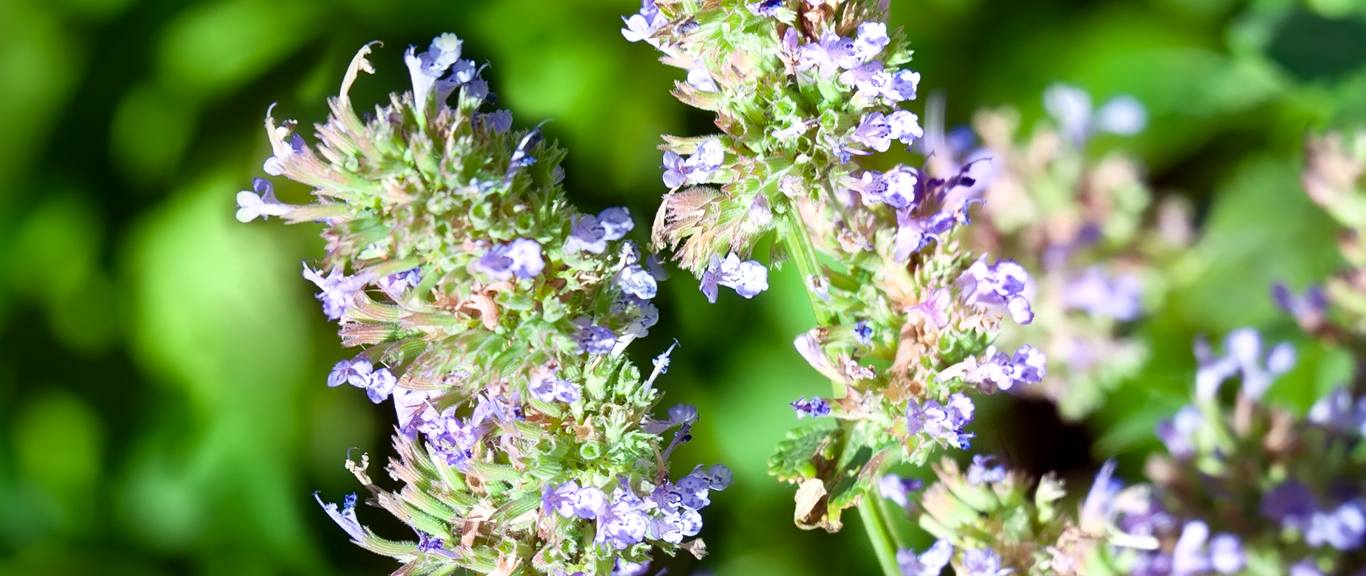Herb Spotlight - Catnip
Catnip (Nepeta cataria)
Family: Lamiaceae
Part Used: Aerial parts
Flavor/Aroma: Bitter
Energetics: Cooling, Drying
Overview:
Also known as Catmint, Catnip has been utilized as a mild sedative, having a relaxing effect on both the mind and body. It is a common garden herb whose name speaks to its relationship with its feline companions- used to calm cats, avoid attacks, and promote domesticity.¹

Botany:
Catnip is a perennial herb native to Europe, Asia, and the Middle Eastern regions, but has since been naturalized in many places throughout the world including North America. It has rigged-edge, heart shaped, fuzzy leaves attached to square, green and purple tinted stems; and produces pink and white flowers when in bloom.²
Cultivation and Harvesting:
Catnip is best harvested in peak summer months, and only the more tender stems and leaves should be collected. If harvested annually, less woody stems will develop.
Southern Oregon Cultivation:
Catnip, like others in the mint family, grows best in the rocky, distured soils of riverbanks and hillsides. It thrives in Southern Oregon’s warmer climates, and its flowers provide valuable sustenance to local pollinators alike. Catnip can be cultivated in sun or shade, and is found in the wild throughout different areas of the state.
History and Folklore:
American Indian Uses: Catnip has been used to treat colic in irritable children and infants when given as a warm tea.³ Catnip would also be brewed as a tea for love potions and for sleep support.
Old British boxers believed that chewing the leaves of the plant would make them a more fierce competitor.¹
Other Uses: Catnip has been used traditionally to relieve nausea and a general upset stomach; it was also used to remedy flatulence and used topically for skin ailments such as mild burns and scratches.²
Modern Applications:
Catnip has been indicated for menstrual cramps and mild pain relief, to aid in tooth and gum aches- by chewing the leaves, for asthmatic support - through smoking the dried leaf and inhaling the fumes, and as a topical antibacterial to help prevent infections; it is also used for irritable children, gastric support, and as a gentle muscle relaxer. 2,3
Uses and Preparations:
Dried Herb Tea Preparation:
1-2 teaspoons per cup of water.
Using a reusable tea bag or tea ball, immerse the loose dried herbs into boiling water and allow to steep for 5-10 minutes, preferably covered, in order to release the maximum amount of herbal goodness. Some herbal tea can carry a strong flavor. We recommend organic honey as a sweetener which preserves the beneficial herbal compounds.
Tincture:
2-4 mL up to 4 times per day, and more as needed.
Some herbal tinctures can have a strong flavor on their own. Adding your tincture to a glass of 6-8oz of water is one easy way to help, should you wish to dilute the flavor.
Inhalation:
Dried leaves can be mixed with other smokable herbs, or smoked alone, to support sleep and relaxation.
Recommended Usage:
It is important to remember that some bodies may react differently than others when using herbal products. Our recommended usage amounts are designed to be an average dosage only. If you have specific concerns about the usage amount or interaction with other medication, please consult with your doctor or health care practitioner prior to using our products.
Sun God Medicinals products that contain Catnip:
Heka Calm and Peace Herbal Tincture
Heka Calm and Peace Herbal Elixir
Precautions:
Not for use in pregnancy except under the supervision of a qualified practitioner due to the emmenagogue and abortifacient effects.
References:
- Catnip (n.d.). www.nativeamericanherbalism.com/meditation/catnip
- Cartaria.-Catnip. (n..d.). www.henriettes-herb.com/eclectic/kings/nepeta.html
- Grognet, J. (1990, June). Catnip: Its uses and effects, past and present. Retrieved from https://www.ncbi.nlm.nih.gov/pmc/articles/PMC1480656/
For educational purposes only. This information has not been evaluated by the Food and Drug Administration. This information is not intended to diagnose, treat, cure, or prevent any disease.


